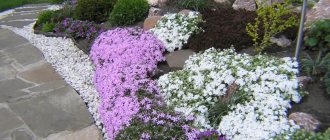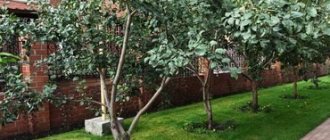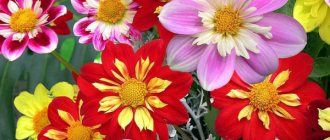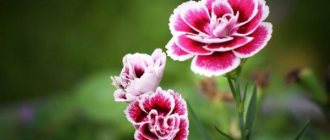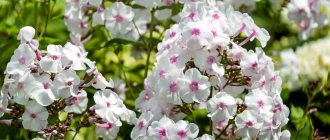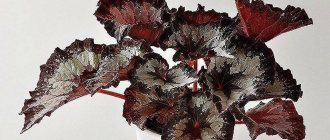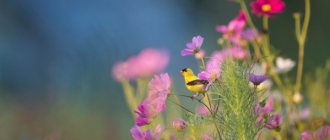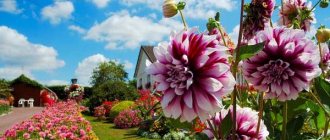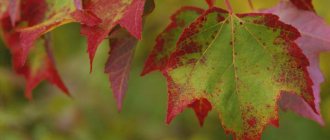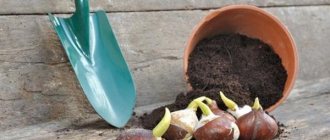- 125533
- landing
Herbaceous biennial plants are monocarpic (from the Greek words monos - one, karpos - fruit), producing flowers or fruits once in a lifetime. These also include annuals and, as an exception, several perennials that die after fruiting: some types of bamboos, American agave.
The perennial American agave lives 10-15 years, but blooms once in its life and then dies.
note
Annual plants go through their entire life cycle, from seed planted in the soil to the formation of flowers and fruits, in one growing season.
Perennial herbaceous plants retain their root system for several growing seasons, while their aboveground part dies in winter.
Biennials derive their origin from perennials, forced to adapt to the conditions of arid or cold climates. In the first year, a leaf rosette is formed at the surface of the earth; in the second year, shoot growth occurs, flowering and the formation of fruits and seeds.
In the first year, celery develops a root (or a large, rounded root crop) with a large rosette of leaves. The next year, celery forms a stem up to 1 m high with small umbrellas of inflorescences.
How to distinguish
From the name it is clear that the first ones have a life cycle that occurs in one summer - germination, growth, flowering and fruiting. Biennial flowers and plants are few in nature. In the first summer they grow roots, a short stem and leaves. By winter, their leaves wither, falling to the ground along with the stem. And biennial plants remain for the winter (on the ground or in storage) - they need exposure to cold, without this they will not bloom in another, the second summer in their life. In the spring, biennials throw out a more powerful trunk and abundant leaves, bloom flowers (or form tubers, fruits). After flowering, the seeds ripen in them, after which the plants die. That's what biennial plants are. Examples of perennials are more numerous - these are plants that settle in the ground for a long time, bloom every summer, remaining to winter in the ground, of course, under favorable conditions for this.
What is the difference between annual plants and biennials
There is not a single garden, flower garden or flower bed that does not have both annual and biennial plants. In just a few months, sometimes a rather tall plant grows from a tiny seed, which blooms profusely, produces seeds and dies, only to delight again next year with its beautiful and fragrant flowers.
The list of annual plants is huge and includes more than one thousand species and varieties. However, among them there are also perennials, which, due to our climate, are classified as annuals. For example, snapdragon or petunia, the cultivation of which is not at all difficult. They delight us with their flowering right up to the frost, and if it weren’t for the cold snap, they could probably grow forever and produce more and more shoots with flowers.
Biennial plants differ from the first ones in that in the first year of their life they do not bloom, but only increase their green mass, and the flowering itself occurs in the second year, after which the plant dies before producing seeds.
Sowing of annuals can be done directly into the ground or into seedling boxes. The earlier the seeds are sown, the faster flowering will occur. Plants sown directly in open ground bloom much later than those grown from seedlings.
Some annuals give good self-sowing if the climate is favorable, for example, snapdragon, simple petunia, aster (Callistephus sinensis), calendula and others.
Sowing seeds for different plants is done differently. Some need to be covered with a layer of soil, some germinate in the light without being buried in the ground. Growing through seedlings allows you to obtain strong seedlings, since during the growth process weak plants are removed, and only the tallest and strongest remain.
Growing annual and biennial plants allows you to collect your seeds and decorate gardens and flower beds with bright flowering plants, from which you can create various compositions or real pictures in flower beds and flower beds. They can be placed in any containers, made into vertical and horizontal compositions, and all thanks to the fact that the root system of annuals does not require too much land.
Annual, biennial and perennial plants are constant companions in landscape design, on alpine hills in ridges, flower beds and all other flower beds. They fill the empty spaces between waves of perennial blooms. It is impossible to imagine balconies and loggias without these wonderful plants, beautifully flowering and unpretentious.
Examples of annual, biennial and perennial plants
First let's go into the garden. What annuals grow here? First of all - potatoes, radishes, tomatoes, peppers (sweet and bitter), cucumber, savoy and Chinese cabbage, watermelon, melon, pumpkin (the pumpkin itself and its “relatives” - crookneck, zucchini, squash), eggplant, beans, peas, soybeans, corn, sunflower, physalis, rapeseed, borage, anise, basil, hyssop, coriander, dill, fennel, savory, chervil, purslane, all kinds of salads (including watercress), spinach, mustard greens, marjoram. For all of these plants, life begins with sowing seeds in the spring and ends in the fall with harvesting in the form of tubers, root crops, and seeds, which give rise to life for their own kind in the next season.
Examples of biennial plants: cabbage (red, white, Brussels sprouts, kale, kohlrabi). From onions - leeks and shallots. Root biennial plants - examples: carrots, rutabaga, turnips, radishes (white and black), beets, parsley, celery, parsnips. Leafy ones - parsley and celery - are also two-year-olds. Little-known but valuable biennial plants grown, examples: Swiss chard, chicory, endive lettuce, scorzonera, oat root, shallots. Cumin is one of the aromatic biennials. Perennials are Jerusalem artichoke, sorrel, the onion family (the well-known trumpet, the little-known slime, multi-tiered and chives), rhubarb, horseradish, artichoke, asparagus, stachys. Spicy aromatics: tarragon (aka tarragon), lovage, thyme, lemon balm, mint.
Lesson summary and presentation “Annual, biennial and perennial plants”, knowledge of the world, 3rd grade
Topic: Annual, biennial and perennial plants
Target:
summarize and systematize students’ knowledge about the life expectancy of various plants on our planet; foster respect for the environment; the formation in children of a moral and aesthetic attitude towards plants as part of living nature; develop oral speech, memory, thinking, attention, imagination of students.
Resources:
TSO.
During the classes:
- Organizing time. Setting a learning goal.
- Updating basic knowledge.
The teacher reads out the words of Nikolai Rylenkov:
Nature does not hide its secrets from us.
But it teaches you to be more attentive to her.
The plant world is the source of life on Earth. Wherever we look, we see plants everywhere: in fields, meadows, forests, steppes, mountains, deserts, swamps, seas, oceans, rivers. The existence of humans, animals, and microorganisms is impossible without the green ocean, which is a factory of atmospheric oxygen. Plants saturate the air with phytoncides - volatile substances that kill pathogenic microbes. Plants muffle various noises and serve as a dust filter. The local climate depends on plants. Plants are eaten by humans and fed to livestock.
In the last lesson, we learned how many years different plants can live on Earth. And now we will complete the first task on reference sheets in order to repeat and consolidate the acquired knowledge about the life expectancy of various plants.
Filling out tables.
- Note the distinctive features of annual, biennial and perennial plants, and give examples of such plants.
Group 1 - annual plants - live for one season, only a few months; in the spring they sprout from seeds, bloom in summer and autumn, produce fruits with seeds and die (wheat, rice, corn, millet, barley, tomatoes, cucumbers, eggplants, pumpkins, watermelons, peas, sunflowers, peppers).
Group 2 - biennial plants - in the first year of life they sprout from seeds, roots, stems, leaves grow, but they do not bloom; in autumn the above-ground part dies, and the root remains in the soil; in spring new stems and leaves grow from the roots; flowers and fruits with seeds appear in their second year; Having given seeds, biennial plants die (carrots, radishes, turnips, beets, cabbage, parsley).
Group 3 - perennial plants - trees and shrubs, many types of herbaceous plants live for many years, they bloom and produce seeds every year; every year new foliage appears on them, the trunk becomes wider, they grow, they become taller and taller (dandelion, plantain, burdock, onion, garlic, tulip, nettle).
- Collective learning activities
- Discovery of new knowledge, skills and abilities.
- Consolidation of learned knowledge, skills and abilities.
- Repetition of learned knowledge, skills and abilities.
Acquaintance with interesting facts from the life of long-lived plants.
The teacher reads out information about various plants. Children solve puzzles and fill in the gaps in sentences.
Each country has its own centuries-old history. And in the world there will be many living, silent witnesses of times that have sunk into oblivion. The most respected “grandfathers” and “grandmothers” in the world of plants... Many of the plants are long-lived
they even have their own names, like people... It’s an unforgettable feeling to be next to a long-lived tree. Just think, these are the most ancient living creatures on earth! They are eyewitnesses of all the great events of human civilization.
Norway spruce
is
one of the longest-living trees on our planet . The oldest spruce is 9550 years old and grows in Sweden. And it is called unusually - “Old Tzhikko”, after the deceased dog of the geologist who “found” it. Interestingly, the spruce does not look old at all. Scientists have discovered an unexpected coincidence: according to them, the slender spruce has the same genetic material as the remains underneath it. It turns out that after dying, the ancient tree, for unknown reasons, gave rise to a young shoot, thereby extending its life.
Next on the list of long-lived trees is the sequoia.
and
baobab
.
Their age can reach 5000 years. In addition, sequoia is one of the tallest trees on the planet, the height of individual specimens reaches 115 meters. California's huge 84-meter sequoia
"General Sherman" with a girth of 31 m grows in Sequoia National Park. Not only the size is huge, but also the age is “respected” - from 2300 to 2700 years. Sequoia bark is very thick, in some places up to 30 centimeters. It has one unusual property: when it comes into contact with fire, it chars and turns into thermal protection for wood. When you walk among these giants, you get the impression that you are in a fairy tale!
Baobab
is one of the thickest: the circumference of its trunk can be 9-10 meters, while it is small in height, only 18-25 meters. A unique feature of baobab is its ability to absorb up to 120 thousand liters of water. Beneath the tree's thick bark are soft and porous tissues that absorb water like a sponge and are essential for the tree's survival during Africa's long drought. The oldest tree in the world is considered to be the baobab, which grows in eastern Africa. He is 5000 years old.
Next on the list of long-living trees is the Banyan tree. The banyan tree, or as it is also called the forest tree, has not one, but thousands of trunks. In its center is the main trunk, thick shoots grow from it, from these shoots branches stretch down, which, having reached the soil, take root. After this, they begin to grow in thickness, and subsequently the secondary trunks become similar to the main trunk, and begin to send out their young shoots... One of the oldest banyan trees has been growing in India for more than 3 thousand years and consists of 3 thousand small and 3 thousand large trunks in height more than 60 meters each.
The sad fate of the pine tree
with the hot name “Prometheus”, cut down in 1964 in Nevada. After research, it turned out that the “old lady” is very respectable - 5000 years old. After the death of “Prometheus”, the palm tree among long-lived plants was taken by a pine of the same species from California. Now “Methuselah,” as he was called, is approaching the age limit of 4845 years. It is the oldest individual living plant on the planet. Nearby grow more than a dozen old pine trees several meters high, with a trunk thickness not exceeding 1 m.
Evergreen 25-meter cypress
“Zoroatrina Sarv”, growing in Iran, has been witnessing events in Asia for about 4000 years.
The Senator cypress grows in Big Trees Park in Florida Its age is 3400-3500 years.
olive trees still bear fruit
in Italian Sardinia, 2 trees on the Arabian Peninsula and 5 olive trees in Israel. Hey oldies!
The abarco tree with the euphonious name “Handsome Patriarch” has been growing in Brazil for about 3,000 years.
Plants are long-lived among shrubs - the low-growing, luxurious, moss-like bush of Llareta
3000 years old. It grows only 1 mm per year. Its element is the South American Andes.
The yew is recognized as a national treasure of Great Britain
, who has been living in the courtyard of the parish church of the village of Llangernew in Wales for approximately 4,000 years. Although its core dies, new shoots constantly “rise”, ensuring the growth of the giant.
The oldest chestnut tree
in the world, the “Hundred Horse Chestnut” grows on the eastern slope of Mount Etna. Several trunks have a common root. The age of the venerable old man is estimated from 2000 to 4000 years.
The oldest flower is the rose
, growing in the German city of Hilgesheim. She is about a thousand years old. It’s amazing that wonderful flowers still bloom on it every spring.
If plants could speak, they could tell a lot. But... the silent old-timers keep the secret... of their longevity... and history.
Fizminutka
The little seed was cold in the soil in winter; it squeezed to keep warm (muscle tension, eyes closed).
In spring, the sun's rays warmed the earth, and the seed warmed up and straightened its shoulders (muscle relaxation).
He became so interested in what was up there that it slowly began to grow. It has roots and first leaves (children get to their feet, open their eyes, raise their arms above their heads, bent at the elbows).
The sun warmed the sprout that emerged from the seed so much that it decided to become tall and tall in order to wave its leaves to the sun (children stretch up, rise on tiptoe, wave their hands).
And then one day a flower bloomed on a sprout, it smiled at the sun and other flowers (children smile at the teacher and each other, turning from side to side).
And then autumn came and in place of the flower, seeds formed, which the plant dropped into the soil (hand movements, as if shaking off water, are aimed at relieving accumulated muscle tension).
This is how the plant grew for a whole year.
- Independent learning activities
And now I suggest you solve interesting problems about the life expectancy of various plants.
- Oak lives 1000 years, and birch is 850 years less than oak. How many years does a birch tree live?
- Resin moss recovers in 30 years if a person walks over it. And 100 years after the passage of a tracked vehicle. How long will it take lichen moss to recover after being passed by a tracked vehicle?
- Express in units of time:
- Linden lives 800 years = _____ centuries
- Spruce lives 4 centuries = _____ years
- Poplar lives 1 century = ____ years
- Come up with and write down your problem using the data: larch lives 420 years, lichen - 70 years.
- Homework:
prepare a message about the plant.
- Summing up the lesson.
— What new and useful things did you learn in class today? Will this knowledge be useful to you in life? What was the most difficult? What did you enjoy doing most? What helped you cope with tasks?
Flowering biennial plants
Below are examples of those biennials that are loved by many and therefore well known.
Turkish carnations are the most beautiful Dutch varieties of these flowers - bright, large, velvety and tall. They love a sunny place and rich humus. Intolerant of moisture stagnation. Effective in large lush groups. They should be protected from freezing by covering them with a layer of sawdust before winter.
The middle bell is a flowering plant of extraordinary, enchanting beauty. Pyramid-shaped bushes 0.5 - 0.9 m high, with large double flowers of blue, purple, pink and white colors. Loves the sun, needs to be watered at the root. Afraid of winds - needs support.
Daisy is a beauty of spring, a light-loving and cold-resistant baby (up to 10 cm in height). When sown early, it will try to bloom in the first summer, but it blooms profusely after wintering - it produces 20 - 30 inflorescences at a time. Colors: white, pink, red, burgundy. Prefers loose, nutritious soil.
Forget-me-not is an unpretentious blue-eyed early spring miracle. Height 20 cm. Good next to tulips, daffodils, pansies, primrose. Rich blooms in a cool location with lacy shade. Decorates the garden and bouquets.
Viola - pansy. Without them, a flower garden is boring. Blooming profusely, curious, of all kinds of colors. Selection and hybridization did their job, turning a small meadow flower into a real miracle.
Perennial flowers (Bennials)
Biennials include plants that bloom and have a maximum decorative effect the next year after sowing. Some of them are perennials (foxglove, daisy, Vitrocca violet, Grenadine carnation), but they are used as biennial crops. If sowed in early spring, Vitrocca violet and early daisy varieties can bloom in the same year.
The big advantage of these crops in the middle zone is the ability to grow seedlings without shelter in nurseries and their good overwintering with minimal shelter. Peat or humus is used to cover biennials.
Biennials reproduce well by seeds, but in some cases (dense daisies, red-colored varieties of Vitrocca violets) a vegetative method of maintaining plants can be used.
In pansies, daisies and forget-me-nots, by the end of summer, with sufficient moisture, seedlings grow from the seeds that fell in the summer. For forget-me-nots, this self-seeding can be left in the same place or planted in a new place. In daisies and pansies, plants from self-sowing can also be left to flower, but their decorative value is usually worse than that of plants obtained from seeds from specially selected most ornamental plants.
The main part of biennials blooms in spring and early summer, which allows them to be used most widely for spring decoration, cutting and forcing in winter and early spring. With the help of film coverings, the flowering of these biennials can be accelerated.
TABLE OF FLOWERING PERENNIALS
